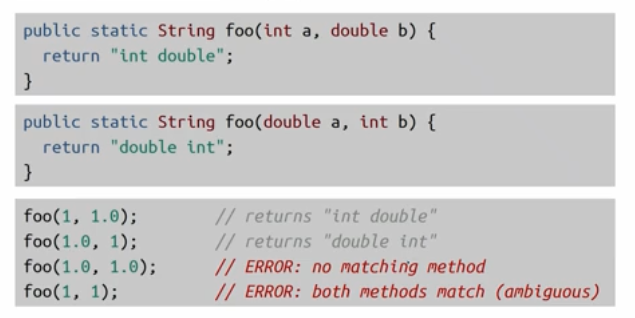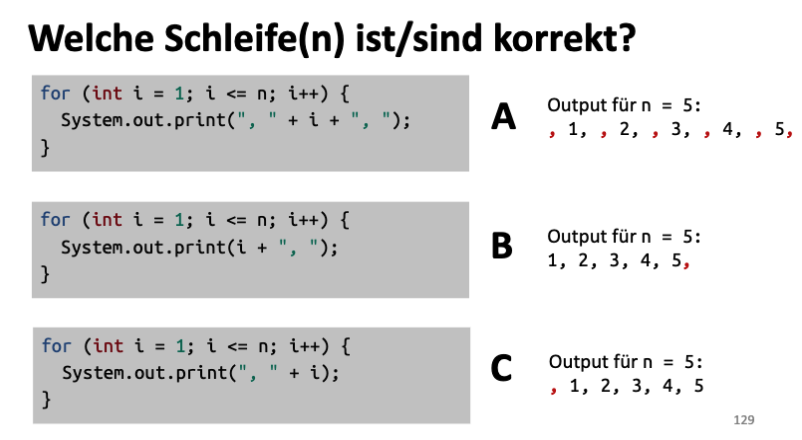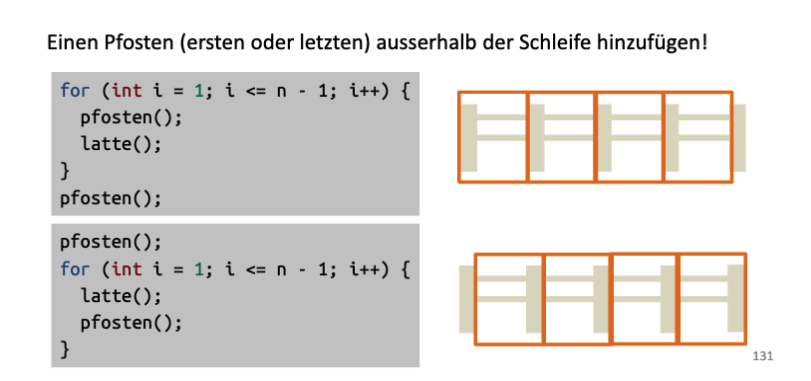Lecture from: 08.10.2024 | Video: Videos ETHZ
Functions
Look at: Functions first.
Function Overloading: Same Name, Different Meanings
One of the powerful features of functions is overloading – defining multiple functions with the same name but different parameter lists. The compiler figures out which version to call based on the arguments you provide. This lets you create flexible and expressive code.
// Prints a single message
public static void printMessage(String message) {
System.out.println(message);
}
// Prints a message with a prefix
public static void printMessage(String message, String prefix) {
System.out.println(prefix + " " + message);
}Important: When using function overloading, ensure that the function signatures (name and parameters) are distinct enough to avoid confusion or errors.

Loops
Look at: Loops Repeating Actions with Precision first.
Increment and Decrement Operators
When working with loops, you’ll often need to modify a counter variable to control how many times the loop runs. This is where increment and decrement operators come in handy:
-
Post-increment/Decrement (
i++,i--): These operators increment or decrement the value of a variable after its current value is used in the expression.- Example:
x = i++;first assigns the current value ofitox, then increasesiby 1.
- Example:
-
Pre-increment/Decrement (
++i,--i): These operators increment or decrement the value of a variable before its value is used in the expression.- Example:
x = ++i;first increasesiby 1, then assigns the new value ofitox.
- Example:
While i++ and i-- are the most common, Java offers a whole suite of shorthand operators for modifying variables directly within expressions. These are called “compound assignment operators.”
- Addition:
+=: Equivalent tox = x + y;(Example:count += 1;) - Subtraction:
-=: Equivalent tox = x - y;(Example:total -= cost;) - Multiplication:
*=: Equivalent tox = x * y;(Example:area *= width;) - Division:
/=: Equivalent tox = x / y;(Example:average /= count;) - Modulus:
%=: Equivalent tox = x % y;(Example:remainder %= 10;)
Side Effects
Let’s examine a scenario that highlights side effects, those unintended consequences that can occur within expressions.
Example:
boolean p = ...; // The initial value of 'p' is unknown
int x = 2;
boolean q = p && x++ < 3;
System.out.println("x: " + x); // What is x going to be?Breakdown:
- Initialization: We start with
xset to2, but the initial value of the boolean variablepis unspecified. - The Expression (
q = p && x++ < 3): This expression’s behavior depends on the value ofp:- Case 1:
pis true:- The short-circuiting doesn’t apply because the first condition (
p) is already true. - The comparison
x < 3evaluates totrue(2 is less than 3). Therefore,qbecomestrue. - Crucially, the post-increment operation
x++executes after the comparison. This increasesxby 1, makingxequal to3.
- The short-circuiting doesn’t apply because the first condition (
- Case 2:
pis false:- Short-circuiting comes into play – the entire expression evaluates to
falsewithout ever reachingx++. Therefore,qbecomesfalse, andxremains unchanged at2.
- Short-circuiting comes into play – the entire expression evaluates to
- Case 1:
Side effects are actions within expressions that change a program’s state unintentionally. In our example:
- The intended outcome was likely determining whether
qwas true or false based on the values ofpandx. - However, the side effect is the modification of
xonly whenpis true.
The Fencepost Error: When Counting Goes Wrong
Imagine you’re tasked with building a fence along a rectangular field. You need to install posts, one at each corner and every n meters in between. Seems straightforward, right? You might think: “If the field is n meters long, I just need n posts!”
But here’s the catch: you also need a post at each end of the field! This common oversight is known as the fencepost error.
The Loop Analogy:

To avoid the fencepost error, remember these key points:
- Include Endpoints: Always ensure that both the first and last elements are accounted for.
- Adjust Loop Range: When dealing with physical quantities, consider starting your loop range from
0or1, depending on the situation, to explicitly include both endpoints.

Do-While Loops
do-while loops are particularly useful when you want to guarantee that the code block executes at least once, even if the condition checking initially evaluates to false.
Structure:
do {
// Code to be executed repeatedly
} while (condition);Example:
int count = 0;
do {
System.out.println("Iteration: " + count);
count++;
} while (count < 5);This code will print:
Iteration: 0
Iteration: 1
Iteration: 2
Iteration: 3
Iteration: 4
When to Use do-while:
- When you need to ensure that a piece of code executes at least once, regardless of the initial condition.
- For user input validation – where you want to keep prompting for input until a valid value is entered.
